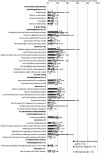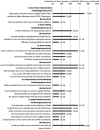Using the Consolidated Framework for Implementation Research to evaluate a nationwide depression prevention project (ImplementIT) from the perspective of health care workers and implementers: Results on the implementation of digital interventions for farmers
- PMID: 36761450
- PMCID: PMC9907445
- DOI: 10.3389/fdgth.2022.1083143
Using the Consolidated Framework for Implementation Research to evaluate a nationwide depression prevention project (ImplementIT) from the perspective of health care workers and implementers: Results on the implementation of digital interventions for farmers
Abstract
Introduction: Depression has a significant impact on individuals and society, which is why preventive measures are important. Farmers represent an occupational group exposed to many risk factors for depression. The potential of guided, tailored internet-based interventions and a personalized telephone coaching is evaluated in a German project of the Social Insurance for Agriculture, Forestry and Horticulture (SVLFG). While user outcomes are promising, not much is known about actual routine care use and implementation of the two digital health interventions. This study evaluates the implementation from the perspective of social insurance employees to understand determinants influencing the uptake and implementation of digital interventions to prevent depression in farmers.
Methods: The data collection and analysis are based on the Consolidated Framework for Implementation Research (CFIR). Health care workers (n = 86) and implementers (n = 7) completed online surveys and/or participated in focus groups. The surveys consisted of validated questionnaires used in implementation research, adapted items from the CFIR guide or from other CFIR studies. In addition, we used reporting data to map implementation based on selected CFIR constructs.
Results: Within the five CFIR dimensions, many facilitating factors emerged in relation to intervention characteristics (e.g., relative advantage compared to existing services, evidence and quality) and the inner setting of the SVLFG (e.g., tension for change, compatibility with values and existing working processes). In addition, barriers to implementation were identified in relation to the outer setting (patient needs and resources), inner setting (e.g., available resources, access to knowledge and information) and characteristics of individuals (e.g., self-efficacy). With regard to the implementation process, facilitating factors (formal implementation leaders) as well as hindering factors (reflecting and evaluating) were identified.
Discussion: The findings shed light on the implementation of two digital prevention services in an agricultural setting. While both offerings seem to be widely accepted by health care workers, the results also point to revealed barriers and contribute to recommendations for further service implementation. For instance, special attention should be given to "patient needs and resources" by raising awareness of mental health issues among the target population as well as barriers regarding the inner setting.
Clinical trial registration: German Clinical Trial Registration: [DRKS00017078]. Registered on 18.04.2019.
Keywords: consolidated framework for implementation research (CFIR); depression; farmers; implementation; internet-based intervention; mental health; prevention; telephone coaching.
© 2023 Freund, Ebert, Thielecke, Braun, Baumeister, Berking and Titzler.
Conflict of interest statement
DE has served as a consultant to/on the scientific advisory boards of Sanofi, Novartis, Minddistrict, Lantern, Schoen Kliniken, Ideamed and German health insurance companies (BARMER, Techniker Krankenkasse) and a number of federal chambers for psychotherapy. DE is stakeholder of the GET.ON Institute/HelloBetter, which aims to implement scientific findings related to digital health interventions into routine care. HB has received consultancy fees, fees for lectures/workshops from chambers of psychotherapists and training institutes for psychotherapists in the e-mental-health context and license fees for an internet intervention. MB is scientific advisor of mentalis GmbH and GET.ON Institute/HelloBetter, both providers of digital mental health care products and services. MB is also co-founder and stakeholder of mentalis GmbH. IT reports to have received fees for lectures/workshops in the e-mental-health context from training institutes and congresses for psychotherapists. She was the project lead for the research project ImpleMentAll (funded by the European Commission) at GET.ON, which aimed to investigate the effectiveness of tailored implementation strategies compared to implementation as usual (11/2017-03/2021). JF, JT, LB declare that the research was conducted in the absence of any commercial or financial relationships that could be construed as a potential conflict of interest.
Figures




References
-
- World Health Organization. Depression and other common mental disorders: Global health estimates. Geneva: World Health Organization; (2017).
-
- Smith M. Stigma. Adv Psychiatr. (2002) 8:317–23. 10.1192/apt.8.5.317 - DOI
LinkOut - more resources
Full Text Sources

